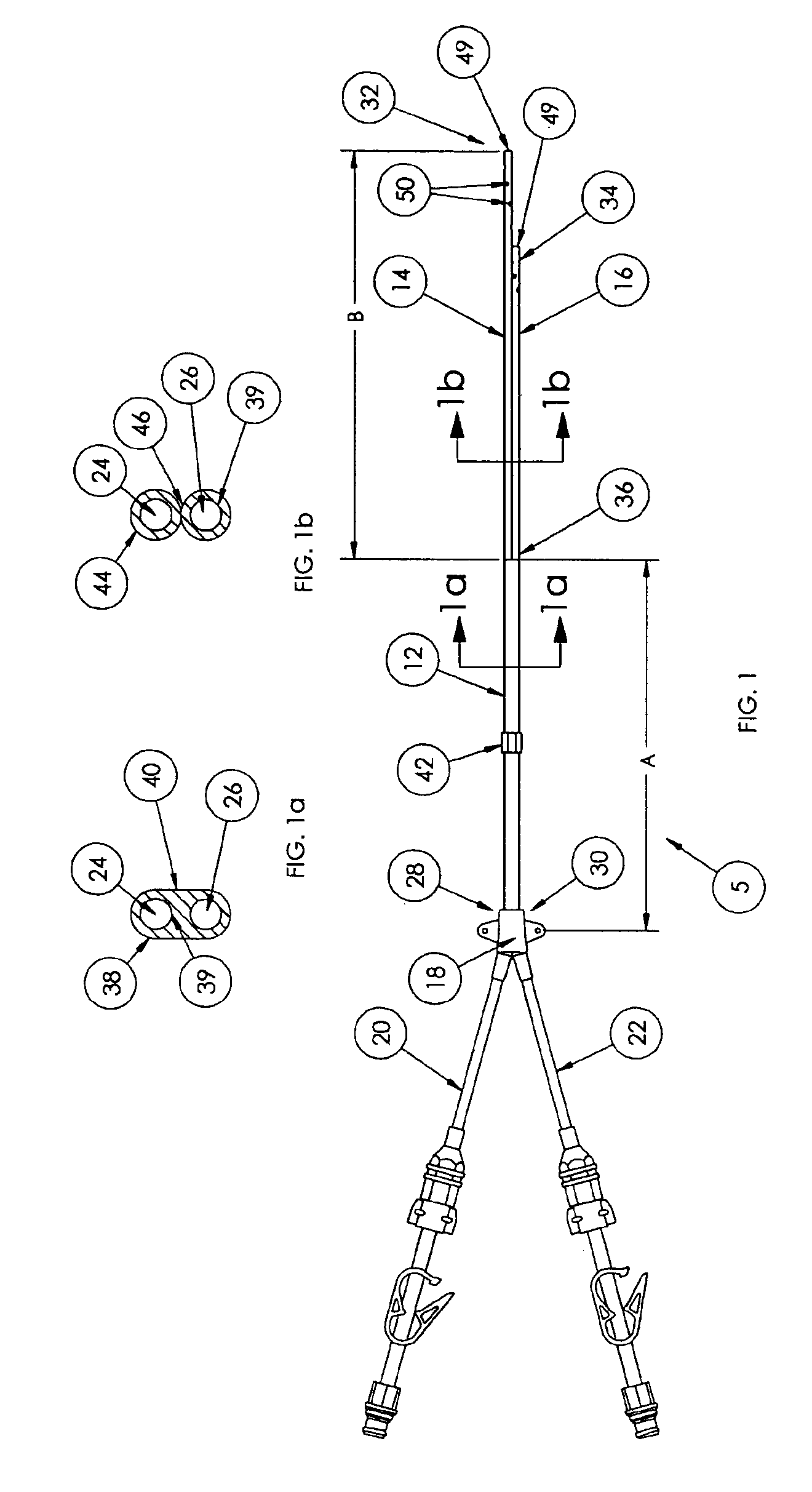Splittable multilumen catheter assembly
a multi-lumen, catheter technology, applied in the direction of multi-lumen catheters, catheters, other medical devices, etc., can solve the problems of increasing the attendant risks of catheterization procedures, the catheter tube leakage potential, and the catheter only being inserted. , to achieve the effect of convenient catheter insertion, efficient fluid flow properties, and facilitating leakage prevention
- Summary
- Abstract
- Description
- Claims
- Application Information
AI Technical Summary
Benefits of technology
Problems solved by technology
Method used
Image
Examples
first embodiment
A First Embodiment
[0050]FIG. 1 illustrates one embodiment of the present invention, where a catheter assembly 5 has at least two lumens. The illustration of two lumens is exemplary, and the scope of the invention encompasses catheters having more than two lumens.
[0051]The catheter assembly 5 includes a unitary catheter 12, a first distal end tube 14, a second distal end tube 16, a hub 18, and a first and a second extension tube 20, 22. The multilumen catheter assembly 5 includes a first lumen 24 and a second lumen 26 extending longitudinally therethrough (see FIGS. 1a and 1b), the first lumen 24 and the second lumen 26 having proximal ends 28, 30, respectively, terminating within the hub 18, and distal ends 32, 34, respectively, terminating at distal ends 32, 34 of the first and the second distal end tubes 14, 16.
[0052]The first lumen 24 is continuous with and through the first extension tube 20, and the second lumen 26 is continuous with and through the second extension tube 22, bo...
second embodiment
A Second Embodiment
[0065]FIG. 4 illustrates a catheter assembly 6, which is a second embodiment of the present invention, an embodiment having additional limitations relative to the catheter assembly 5 of FIG. 1. The catheter assembly 6 of FIG. 4 is primarily distinguished from the catheter assembly 5 of FIG. 1 over the portion of the catheter assembly 6 between the distal ends 32, 34 and the transition-point 36 (over the portion of the longitudinal length of the catheter assembly 6 generally denoted by Arrow “B” in FIG. 4). In one aspect of the FIG. 4 embodiment, the transition-point 36 is located at a point along the longitudinal length of the lumens 24, 26 such that the length of the longer of the first and the second distal end tubes 14, 16 (the Arrow “B” portion) is greater than the length of the unitary catheter 12 (the Arrow “A” portion).
[0066]In the FIG. 4 embodiment, the outer walls 44 of the first and the second distal end tubes 14, 16 are releasably attached from the tran...
third embodiment
A Third Embodiment
[0072]FIG. 5 illustrates a catheter assembly 7, which is a third embodiment of the present invention. The catheter assembly 7 of FIG. 5 is primarily distinguished from the catheter assembly 5 of FIG. 1 over the portion of the catheter assembly 7 between the distal ends 32, 34 and the transition-point 36 (over the portion of the longitudinal length of the catheter assembly 7 generally denoted by Arrow “B” in FIG. 5).
[0073]In the FIG. 5 embodiment, the outer walls 44 of the first and the second distal end tubes 14, 16 are separate (unattached) and independent from the transition point 36 to the distal ends 32, 34 (over the entire Arrow “B” longitudinal length in FIG. 5), as shown in FIG. 5b. The cross section of the first and the second distal end tubes 14, 16 (FIG. 5b) illustrates that the outer walls 44 of the first and the second distal end tubes 14, 16 over the Arrow “B” length, as well as the outer walls 39 of the first and the second lumens 24, 26, are rounded ...
PUM
 Login to View More
Login to View More Abstract
Description
Claims
Application Information
 Login to View More
Login to View More - R&D
- Intellectual Property
- Life Sciences
- Materials
- Tech Scout
- Unparalleled Data Quality
- Higher Quality Content
- 60% Fewer Hallucinations
Browse by: Latest US Patents, China's latest patents, Technical Efficacy Thesaurus, Application Domain, Technology Topic, Popular Technical Reports.
© 2025 PatSnap. All rights reserved.Legal|Privacy policy|Modern Slavery Act Transparency Statement|Sitemap|About US| Contact US: help@patsnap.com



